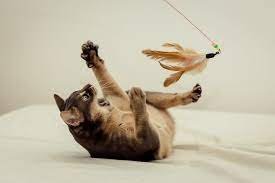How Much Exercise Does Your Cat Need?
We know that exercise is crucial for our feline friends to keep them healthy and ensure good muscle and bone health. It can also help with your cat's coordination when they stalk, chase and attack their prey. Obesity in cats is a problem and engaging in play every day with your cat can help reduce their risk for being overweight. Another reason we need to make sure our cats are getting adequate physical play is that it leads to mental stimulation. Exercise helps avoid depression in humans, as well as in our pets, and studies show about 40% of cats suffer from this due to boredom. We know pets who do not have enough physical and mental stimulation can develop behavioral problems, which can be destructive, such as scratching furniture, chewing or being overly hyperactive.
On average, cats need about 30 minutes of physical activity every day. The amount of exercise required might also change depending on your cat’s age and whether they are indoor-only cats. Naturally, cats are hunters and respond to stimuli quickly. If you have an indoor/outdoor cat, while I do not agree with it, those cats who go outdoors require a different exercise regime than indoor cats do. Cats who venture outdoors have unlimited space to roam, they are more physically active and tend to get enough exercise naturally. Also being outdoors those cats are exposed to stimuli such as bugs and leaves which motivates them to perform stunts and be more active. Indoor cats have limited space and less exposure to natural stimuli unless they are like my cat, Phoebe, who finds spiders in the basement we didn't even know were down there. We need to make sure we are motivating our cats to participate in interactive games. You can do this by using toys like feathers, ropes and balls to keep them healthy. Engaging in play with your cat helps enforce the bond you have with your pet as well.
Whether your cat is older or is a young kitten also determines how much play they should have each day. Adult cats should exercise daily for at least a half an hour to keep their body fit and healthy. It also helps to keep their hunting skills sharp and provides the mental stimulation they need. On the flip side, kittens and young cats can sleep up to 22 hours a day, so they are naturally not as active as adult cats. Even though they are not as active, you should still exercise them daily with their favorite toys.
Fun and Easy Exercises for Indoor Cats
Bathtub Ball. With a dry bathtub, toss a ball inside. Your feline friend will be able to play freely inside the tub. Cats do not get bored easily when there are moving targets involved, so let them bat the ball around; you can join in and roll it for them to chase.
Laser Pointers. As we mentioned, cats love things in motion. You can use a laser pointer to keep your cat moving. To encourage your cat to play, use the laser pointer to move like a mouse or bug may move. Always remember to reward your cat after playing with the laser pointer, as there is not a tangible item they are catching; a treat can make up for it.
Animal Toys. Cats are very observant creatures and can somehow distinguish the physical appearance of real life and fake stimuli. Consider getting your cats toys that resemble real animals like birds, bugs and mice. To make it more exciting, connect a string to the toys and give the toys some life.
Ribbons and Wands. Tie a ribbon or string to the end of a wand and let your cats chase it around the house. These toys are great while you are engaged in play with your cat, but should be put away when the cat is alone to ensure they do not accidently choke on it.
Food Exercise. Mealtimes are very exciting and tempting for cats, especially when wet food is involved. We can help our cats hone their hunting skills by changing up the places where we feed them, or place the wet food in places they may need to climb or hunt for it.
Get Some Cat Towers. Cats love to climb and jump on things, so encourage them to use a cat tree instead of a couch or chair. Multi-tiered cat towers ensure your pet has lots of places to climb and play. To encourage your cat to climb or jump on their tree, place some treats on different levels to help them explore.
Try Catnip. Catnip and catnip toys are useful to help your cat to exercise. Your cat can have fun eating, rolling and being stimulated by the nip, but please note that some cats do not respond to catnip and some may become overly stimulated by it.
Introduce Leash-Walking. Much like training dogs on a leash, you can entice your cat to walk on a leash and harness outdoors. This can be a safe way to introduce your cat to the outside world. It is best to start young and slowly introduce the harness to your cat. Always make sure the harness is secure so your cat cannot wiggle out of it.
Get Your Cat A Pinata. Cats love batting at hanging objects. Putting kibble or treats in the pinata can motivate your cat to bat and play with the pinata. Your cat will be rewarded for their work as the treats drop from the pinata as your cat plays.
Match Exercise Partners. Unlike dogs, your cat may not respond to your requests to play or engage. You can consider adding a second cat as a playmate. They can get along well and engage each other in fun activities like chasing each other, wrestling or even cuddling.
So, overall, most indoor cats do not receive enough playtime and as pet owners, we should take the time to engage with our pets and ensure they get the physical activity they need. Choose games your cat enjoys or get to know which toys are their favorite. Even if 30 minutes does not fit into your schedule, any amount of vigorous play is great for our cats.



